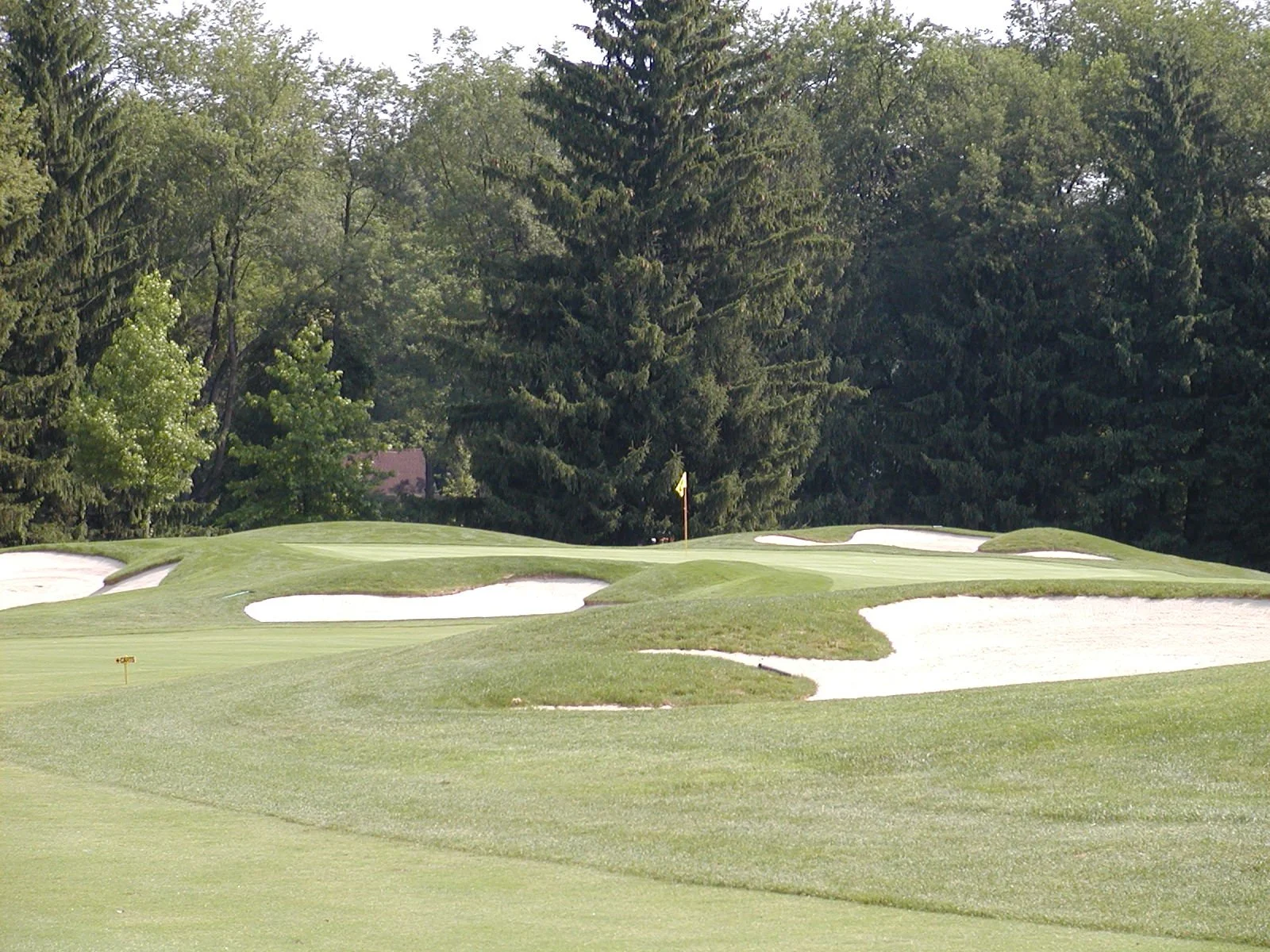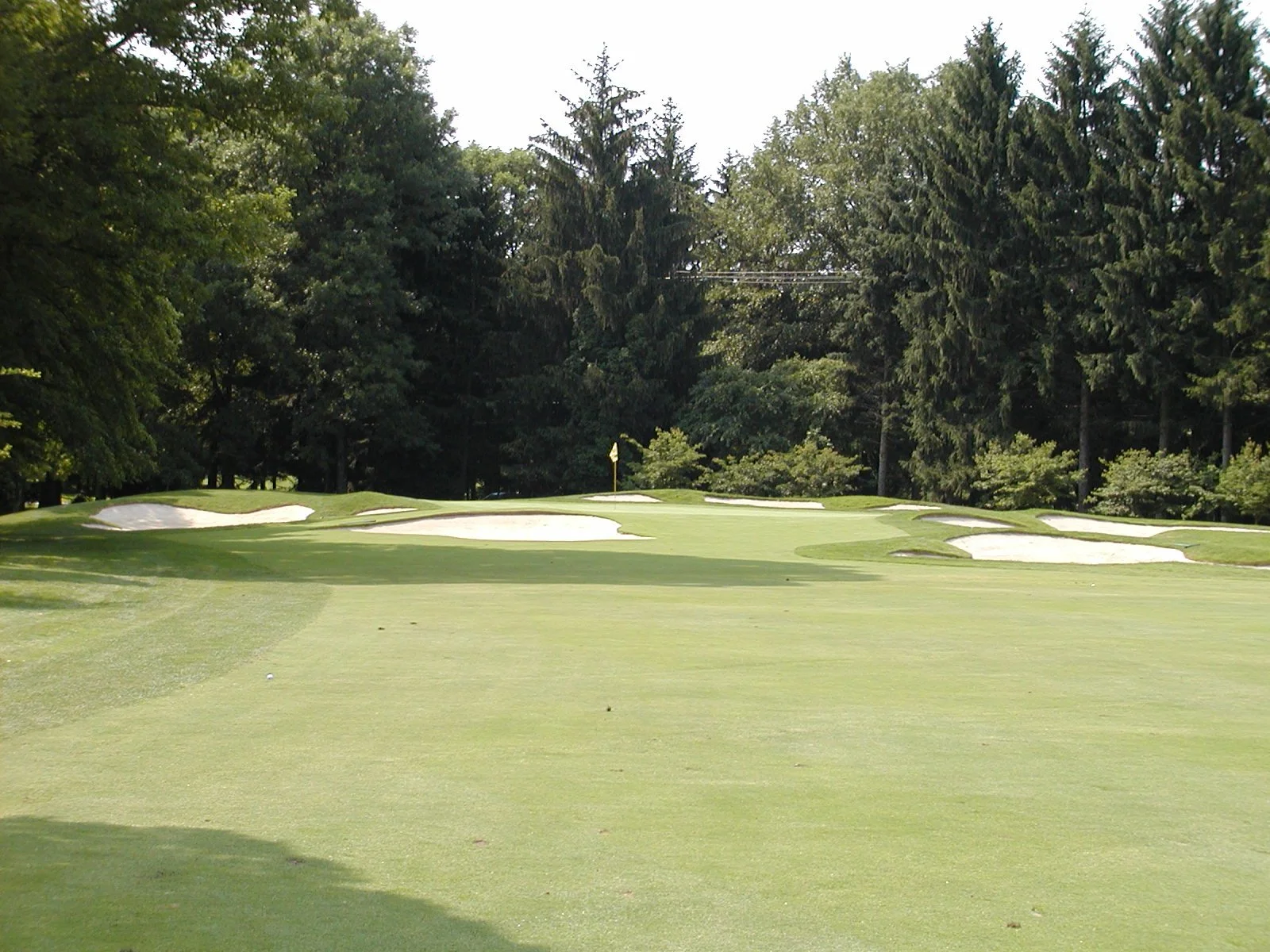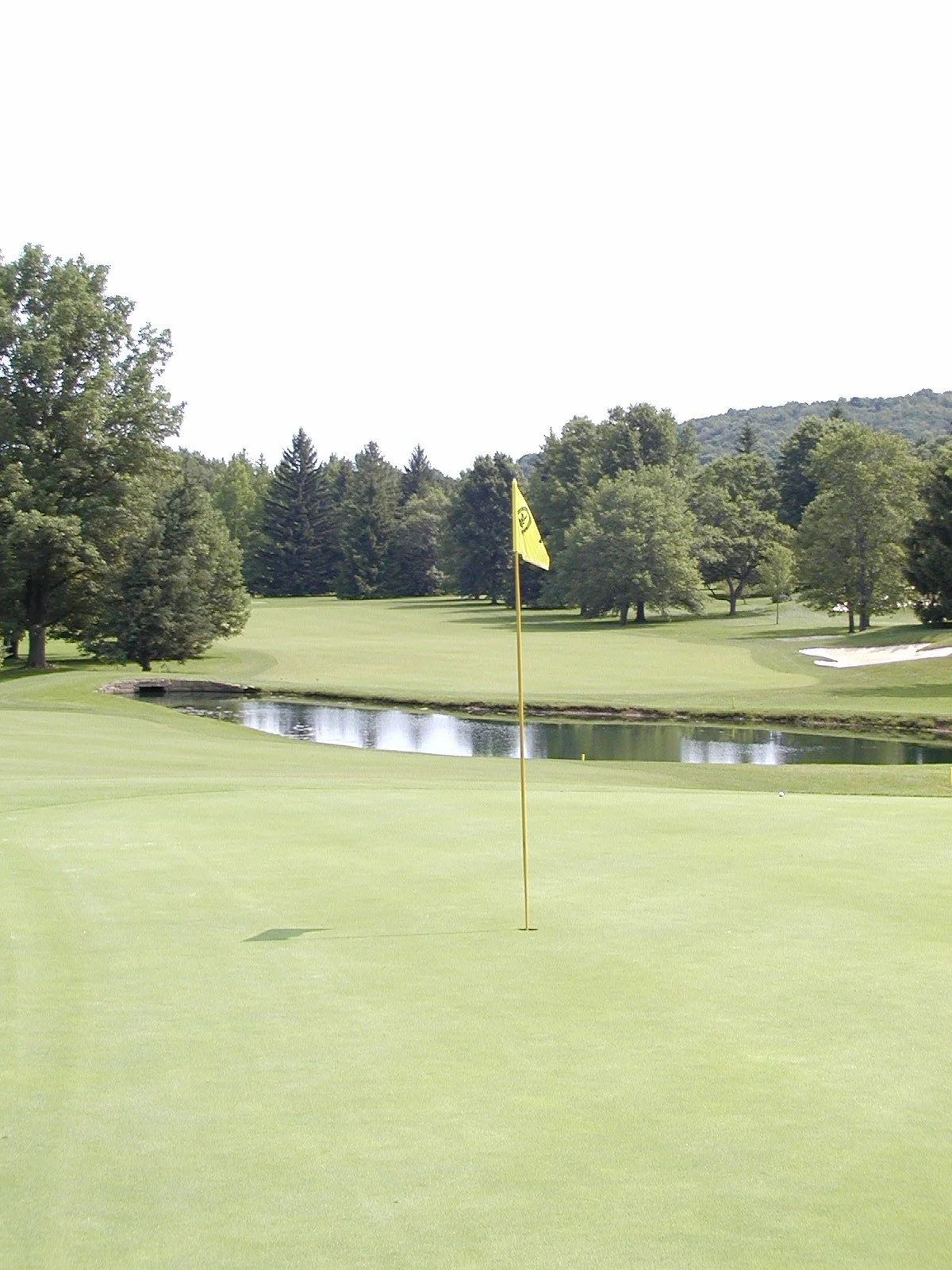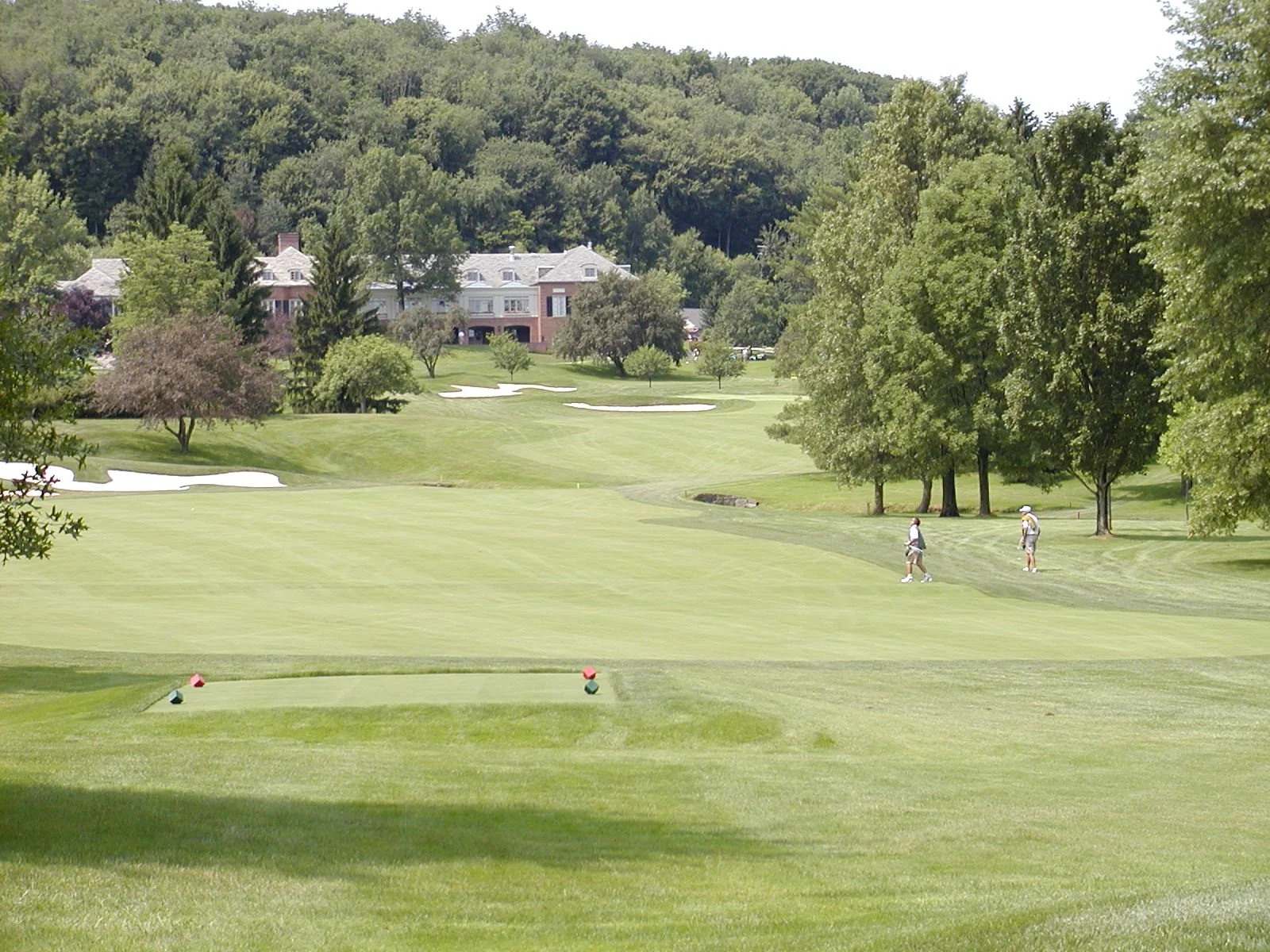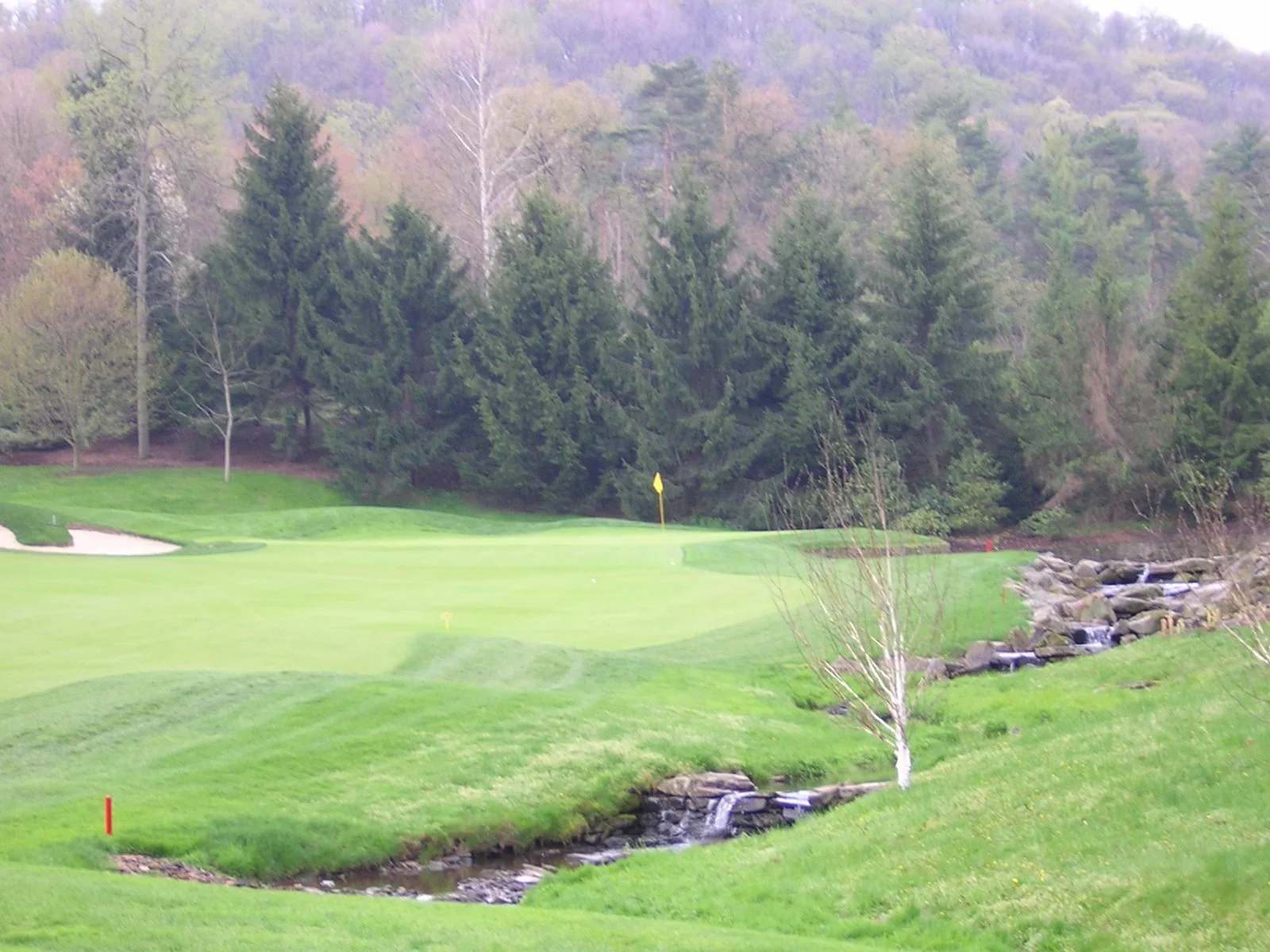LAUREL VALLEY GOLF CLUB
Architect(s): Dick Wilson (1958); Arnold Palmer & Ed Seay (1980s-present)
Year Opened: 1959
Location: Ligonier, Pennsylvania
Slope: 148. Rating: 75.7
Par: 72
Yardage: 7,325
Hole-by-Hole: 1 - Par 4 416 Yds 10 - Par 4 432 Yds
2 - Par 4 410 Yds 11 - Par 5 605 Yds
3 - Par 5 534 Yds 12 - Par 4 447 Yds
4 - Par 4 455 Yds 13 - Par 4 432 Yds
5 - Par 3 208 Yds 14 - Par 3 205 Yds
6 - Par 5 524 Yds 15 - Par 4 375 Yds
7 - Par 4 388 Yds 16 - Par 4 437 Yds
8 - Par 3 221 Yds 17 - Par 3 219 Yds
9 - Par 4 480 Yds 18 - Par 5 537 Yds
Par 36 3,636 Yds Par 36 3,689 Yds
Awards Won: Named 59th by Golf Digest's America's 100 Great Golf Courses,
Named 4th by Golf Digest's Best in State (PA) Rankings.
Events Held: PGA Championship (1965),
National Four-Ball Tournament (1970),
National Team Championship (1971-72),
Ryder Cup (1975),
U.S. Senior Open (1989),
Marconi Pennsylvania Classic (2001),
Senior PGA Championship (2005), Palmer Cup (2023).
HISTORY: In a short period of time, relatively speaking, Laurel Valley Golf Club has grown into a place of history.
Set in the western Pennsylvania Laurel Highlands, Laurel Valley sits upon 260 acres between Laurel Ridge Mountain and Chestnut Ridge Mountain. The land, originally owned by Richard
King Mellon, was given to one of the country's best architects at the time, Dick Wilson to design a masterpiece. Wilson, who designed such classic's as Pine Tree in Florida and NCR South in Ohio, called the tract of rolling grassland, "the most natural, beautiful site I have ever seen for a golf course."
Palmer, who has been part of this club's rich history since its inception, had continued to add various enhancements to the club since the early 60s, as 15 holes have been altered or modified, including the construction of an entirely new 10th hole. PGA of America President M.G. Orender called Laurel Valley, "one of this country's premier venues."
Just five years after the course opened, western Pennsylvania native Arnold Palmer was instrumental in having the club host the 1965 PGA Championship. Heading into the final round, Dave Marr and Tommy Aaron shared the lead at four-under par. While Aaron faded, Marr played steady and held a one-shot lead with one hole remaining. On the then par-four 18th, Marr laid up short of the water fronting the green after a hooked tee shot into a fairway bunker and then hit a nine-iron to three feet to save par and a two-shot win over Billy Casper and Jack Nicklaus. The big
winner was the course however, as the field played to a scoring average of 75.46 with only five players shooting par or better for the week. Palmer, playing in his backyard, as he was born and raised in nearby Latrobe, failed to break 72 and tied for 33rd.
It came as no surprise that the 21st Ryder Cup would be held at Laurel Valley, as you guessed it, Arnold Palmer would serve as captain of the United States squad. Led by Jack Nicklaus, Hale Irwin and Tom Weiskopf, the Americans dominated the players from Great Britain and
Ireland to the tune of 21-11. Nicklaus and Weiskopf dusted off Brian Barnes and Bernard Gallacher in the opening match, as the U.S. stormed out to a 6 1/2 to 1 1/2 day one advantage. Surprisingly, Nicklaus was later beaten in both singles matches by Barnes. Irwin posted a 4-0-1 mark, while Weiskopf was 4-0.
The USGA made its first and only stop to Laurel Valley in 1989, as Orville Moody claimed the U.S. Senior Open. Moody charged into the forefront with a third-round 64 and finished the event with a two-shot win over Frank Beard. With the title, Moody became only the fourth player to win both the Senior Open and U.S. Open, which he captured in 1969. Moody shot 70 in the final round, keyed by an eagle three on the par-five sixth. Despite all of his local knowledge, Palmer could do no better than a tie for 53rd.
In 2001, the PGA Tour made an appearance at Laurel Valley, as Robert Allenby captured the
Pennsylvania Classic. Trailing by four shots after round one, Allenby carded scores of 65-66-68 to post a three-shot win over local favorite Rocco Mediate and Larry Mize. During the event, Stuart Appleby, Kevin Sutherland and Robert Gamez set the competitive course record of 64. Mediate was the only player in the field to post all four rounds in the 60s.
COURSE REVIEW: As you stand on the first tee, the hole offers an outstanding view of the town of Ligonier. A straightaway par-four, the first plays downhill to a fairway flanked on both sides by sand. Just a three-metal is required as your opening shot, setting up a medium- to short-iron to a green that is well guarded by sand and features three distinct ridges in the surface. A big drive on the first could set up a little wedge, however, miss the fairway at Laurel Valley and the deep penal rough will take you from birdie to bogey in a hurry.
From the back tee, the second bends slightly to the left and puts a premium on the tee shot. Five fairway bunkers guard both sides of the landing area, so three-metal should once again be the play. A short-iron will be left to a green fronted by a pond, with bunkers right and deep. The putting surface is only 27 yards deep, but is two-tiered and slopes from back-to-front. Miss long and you'll be lucky to stay on the green. Take par and move on.
A definite birdie chance, the third is the first par-five on the course. This 534-yard dogleg right, requires an accurate tee ball, so as to avoid the two 20-yard bunkers on the right and 30-yard pit on the left. The green can be reached in two, but sand protects the front and left and water guards the back right. If you layup, a mid-iron will leave 80-100 yards, as long as your left of the
bunkers that are place strategically on the right. The putting surface is slightly elevated, long (31 yards deep) and quite narrow.
I would have to concur that the fourth hole is the most difficult on the course. At 430 yards and doglegging to the right, this hole is a bear. Not only that, Palmer and his design team, added a new back tee and re-positioned the bunkers on the right to come more into play. After a successful tee shot, a mid- to long-iron awaits to a green that slopes from back-to-front. So much so, that if you miss above the hole, you will most likely three-putt. The putting surface is well guarded by sand, so make your par and go forward.
The first of four 200 yard-plus par-three's, the fifth requires a long-iron to a long and narrow green.
Pinpoint accuracy is a must, as the putting surface is protected by four difficult bunkers and the green itself is slick and undulating.
The theme on the sixth is sand. Although a definite birdie opportunity, the par-five features sand guarding both sides of the fairway off the tee, then numerous bunkers in the layup zone and a host of troubling sand around the green. The putting surface can be reached in two, but the green is one of the smallest targets on the course, at just 26 yards in depth. The surface slopes from left-to-right and leaves no margin for error, especially with a back-left pin placement.
One of only two par-fours under 400 yards long, the seventh typifies the beauty of Laurel Valley. A three-metal or long-iron, depending upon the wind is needed for a successful tee shot, as a lake stands 275 yards. 60 yards worth of sand bunkers guard the left side, while trees guard the
right. A short-iron will remain to this uphill green that is guarded by a second pond to the left and sand right and deep. The putting surface is quite large at 37 yards and slopes severely from back-to-front. Birdies are quite possible, however, if above the hole, you'll have a tough time making bogey.
Although the eighth hole is quite long, it's not the length that will get you, it's the green. There's no doubt you'll need a long-iron or fairway-metal on this par-three, however the putting surface is 39 yards in depth and features three different levels. Four deep colorful bunkers guard all sides of the green, so making birdie or par for that matter is quite rare.
One of most difficult holes on the course was made harder, as the ninth has a new back tee and the fairway bunkers were pinched in to shorten the landing area. Just for good measure, the hole plays uphill and into the wind. Not quite the recipe for par. A well-placed tee shot will leave a long-iron to a two-tiered green that slopes to the front and is guarded by sand in the front, left and right. The ninth could be the finishing hole at any club in the country.
The back nine is even longer than the front by some 117 yards, so when you get the chance, take advantage of the so-called easy holes. The tenth can fit that category, as it plays drastically downhill and doglegs to the right. Bunkers at the left corner have been brought in to tighten the fairway and trees and a stream that leads to the green guard the right side. A solid tee shot can leave a medium- to short-iron, however the green is quite narrow and with water looming right, watch out. The putting surface is slick, as it slopes back-to-front with a ledge in the center. This hole is pure poetry in motion with the water cascading down and the floral designs.
The 11th is a mammoth par-five of 605 yards and completely different than its original design. The
hole was a dogleg right and has been altered to be a dogleg left, with a new fairway carved to the north. Your tee shot must favor the right side, as most shots will move to the left due to the fairway slope. From here, the player has a couple of options. One, go for the green in two or layup at the 140-150 yard mark. First off, going for the green is quite risky, as the second shot plays severely downhill and features a bunker 44 yards short of the green in the center of the fairway, so run-up shot is eliminated. A medium-iron to layup would be appropriate, to avoid the severe downhill lie if you try to get greedy. The putting surface is quite long and is quite receptive to a short-iron that will set up a birdie. From the top of the hill looking down towards the green, the player is afforded the luxury of the scenic surroundings of Ligonier Valley and Laurel Highlands.
The longest par-five is followed up by the longest par-four on the course, the 12th. This downhill brute, features four bunkers strategically placed to guard the landing area, as the fairway narrows 280 yards from the tee. A quality tee shot to this rolling fairway will leave a medium- to short-iron to the biggest green on the course. The putting surface, 41 yards deep, slopes to the left and is protected by three daunting bunkers. Sometimes, bogey is not such a bad score.
Another great par-four awaits, as you reach the 13th tee. A series of bunkers guard this slight dogleg to the right and a large oak tree protects the left. Even a tee shot that bails left to avoid the sand, can be blocked by the oak. A medium-iron is left to a green that is just 22 yards deep, but very wide. Four bunkers guard the surface, with a back-right the most difficult of all pin placements.
The 14th is a fun par-three that can play as short as 140 yards or as long as 205. The not so fun part, is that a lake runs from tee to green, so club selection is quite key here. The putting surface is very difficult, wide, shallow and features many undulations with three bunkers behind the green. The 14th starts a string of four of the final five holes where water comes into play.
One of the most difficult driving holes on the course, the 15th is only 375 yards, but requires the utmost of accuracy. A lake guards the left side of the dogleg and two bunkers and trees protect the right. A long-iron or fairway-metal must hit the right side of the fairway to leave an unobstructed view of the green. The putting surface is the narrowest on the course, but is quite long at 35 yards in depth. The green funnels toward the center and slopes to the front, so be below the hole for a solid chance at birdie.
It will take a drive of 240 yards plus to carry the water and the corner of the dogleg right 16th. The eighth and last 400-yard plus par-four, the player must be precise off the tee, as to avoid the bunker down the left side of the fairway. A medium- to long-iron will be needed to reach the uphill green that plays longer than the yardage indicates. One of the toughest greens to hit with three difficult sand bunkers playing sentry. Par on any day is a good score here.
The last of the par-three's, the 17th plays slightly uphill, and usually into the wind. A long-iron is required to reach the small, well-bunkered green. The putting surface slopes from left-to-right and back-to-front, so bail out right. You'll have a better chance of getting up-and-down from the sand than two-putting from the left side.
One of the most dramatic holes in golf, the 18th at Laurel Valley can produce a scoring range from three to eight. To have any chance at eagle, the tee shot must be long and favor the right side. This might be difficult however, as a series of bunkers play guardian. The second shot must then carry over water and trees some 240 yards, not an easy chore. To make birdie the old fashioned way, play down the left side off the tee, layup with a medium iron and hit your wedge to within 10 feet. Three bunkers have been added to the left side of the layup zone, just for a little discomfort. The putting surface sits down in an amphitheater, as it was lowered 18 feet in the late 80s, to create even more excitement. Whatever you do, take an extra club, because the alternative is not how you want to finish your round.
FINAL WORD: This is one golf course that rivals the best in Pennsylvania, but is often overlooked, as Oakmont, Merion and Aronimink get most of the attention. Laurel Valley is class with a capital "C".
Over the years, Arnold Palmer had made "his" course into a phenomenal layout with all of the extras. Lush surroundings, impeccable beauty, spectacular setting and of course a great golf course.
Mr. Palmer has created a masterpiece that challenges the best of players and yet is very playable for the higher handicapper. Let's start out with history - PGA Championship, Ryder Cup, that's a 10. Second - layout, you bet. Difficulty - The only rough tougher is Oakmont's.
Next - amenities (Georgian-style clubhouse, staff, practice facility), second to none. What you have is a "Bo Derek" a "10". It's not often you get to play a track that the greats of the game traversed, so if given the opportunity, go for it.
Who know's, you might have gotten to see the king and get an autograph, I did.



